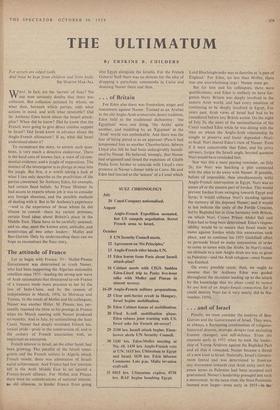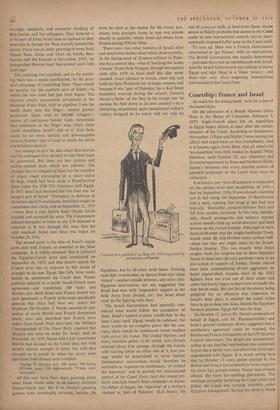. . . and of Israel
Finally, we must consider the motives of Ben- Gurion and the Government of Israel. They were, as always, a fluctuating combination of religious- historical dreams, strategic designs (not excluding frontier changes), and self-defence. From the moment early in 1955 when he took the leader- ship of Young Arabism against the Baghdad Pact and all that it connoted, Nasser became a threat of a new kind to Israel. Naturally, Israel's Govern- ment feared and was determined to frustrate any movement towards real Arab unity until her peace terms in Palestine had been accepted and guaranteed. Nasser's leadership presaged just such a movement. At the same time, the Sinai Peninsula loomed ever larger—even early in 1955—in the' strategic, messianic, and economic thinking of Ben-Gurion and his colleagues. They believed it to be part of Eretz Israel (and so claimed as they went into it, though the West scarcely noticed the claim). There was an inner yearning to wrest back Mount Sinai, Gaza, and Tiran on which, Ben- Gurion told the Knesset in November, 1956, 'an independent Hebrew State' had existed 'until 1400 years ago.'
This yearning was matched, and in the match- ing there was a mystic justification, by the prac- tical advantage of controlling Sinai. There would be security for the southern port of Eilath—to which the new road had just been begun. The massive, utterly uneconomic investment in the National Water Plan, with its pipelines from the north down into the Negev, needed greater protection. Gaza, with its 200,000 refugees— source of continuous border raids—threatened that settlement of the Negev area which alone could consolidate Israel's title to it. And there could be no more natural and advantageous western frontier than a Canal in which the entire world held an interest.
Any attempt to give the date when Ben-Gurion and his colleagues first decided to take Sinai must be guesswork. But there are two curious and seldom-noticed facts which are relevant. The strategic key to conquest of Sinai was the complex of desert roads converging on a place called El-Auja, which had been made a Demilitarised Zone under the 1949 UN Armistice with Egypt. In 1951 Israel had declared that this zone was 'an integral part of Israel.' Thereafter, in defiance of Armistice and UN resolutions, Israel had sought to consolidate that claim, and on September 21, 1955 —more than a year before Suez—Israeli forces invaded and occupied the zone. The Government refused thereafter to listen to any UN demand to evacuate it. It was through this zone that the vital overland thrust into Sinai was begun on October 29, 1956.
The second point is the date of Israel's major arms deal with France, so essential to the Sinai campaign. It is widely assumed that it followed the Egyptian-Czech arms deal announced on September 28, 1955; and that Israel's search for French arms was in response to this access of strength to the new Egypt. But fully three weeks before he announced the Czech deal, Nasser publicly referred to a secret Israeli-French arms agreement—and mentioned 100 tanks and Mystere jets. Both Israel and France denied any such agreement, a French spokesman specifically denying that there had been any orders for Mysteres, On October 3, Nasser announced pos- session of secret British and French documents which, inter alia, described new French arms orders from Israel. Four days later, the Military Correspondent of The Times flatly reported that Mystere jets were on order for Israel. And on November 10, 1955, Nasser told a Life interviewer that he had decided on the Czech deal, not with Israel's current strength in mind, but with that strength as it would be when her secret arms purchases from France were complete
'buying 70 Mystere jets, 100 tanks, 100 heavy 155-mm. guns, 150 high-velocity 75-mm. anti- tank guns.'
All this may have been sheer guessing about what Israel would order in in entirely fictitious Franco-Israeli deal. But if so, Nasser's guessing powers were remarkably accurate, because the arms he cited as the reason for his Czech pur- chases were precisely those, in type and almost exactly in quantity, which Israel did obtain from France during 1956 for Sinai.
There were two other features of Israeli aims and sensitivities before Sinai which deserve notice. In the background of Zionism-militant in Pales- tine lay a central idea—that of 'teaching the Arabs a lesson.' From Orde Wingate, through the reprisal raids after 1949, to Sinai itself this idea never receded. Israel planned to invade, clean out, and hold the Sinai Pensinula for strategic reasons, and because it was 'part of Palestine' (as a Kol Israel broadcast asserted during the attack). General Dayan's Order of the Day to his troops was `to enclose the Nile Army in its own country'—by a shattering, sensational, quite unequivocal military victory designed to be noted well not only by Cartoon first published on May 19, 1954 (reprinted by permission of Punch) Egyptians, but by all other Arab States. Nothing must halt, overshadow, or detract from this 'clean victory'—neither outside pressure, any other anti- Egyptian intervention, nor any suggestion that Israel had won with 'imperialist' support in the field. Arms from abroad, yes : but Israel alone must do the fighting with them. '
The Israeli Government had assuredly con- sidered what would follow the occupation of Sinai. Israel's western frontier would then be the Suez Canal itself. Egypt would be subdued, but there would be no complete peace. On the con- trary, there would be continuous minor warfare right across the Canal. The United Nations, and every maritime power in the world, were already worried about free passage through the Canal; with warring forces on either side of it, free pas- sage would be jeopardised as never before. International intervention would therefore be inevitable to 'separate the combatants,' to 'protect the waterway,' and to provide for international control of the Canal Zone. And this would per- fectly conclude Israel's Sinai campaign—a shame- ful defeat of Egypt; the 'regaining' of a territory claimed as 'part of Palestine' (Kol Israel); the end of fedayeen raids, at least from Gaza; secure access to Eilath; probable free access to the Canal under its new international control; and an inter- nationally-imposed buffer zone on the Canal itself.
To sum up. Here was a French Government determined to 'get Nasser,' with no reservations. The British Government was equally determined —provided there was no identification with Israel. And the Israeli Government was seeking to shame Egypt and take Sinai in a 'clean victory'; and then—but only then—expecting international intervention in the Canal Zone.











































 Previous page
Previous page